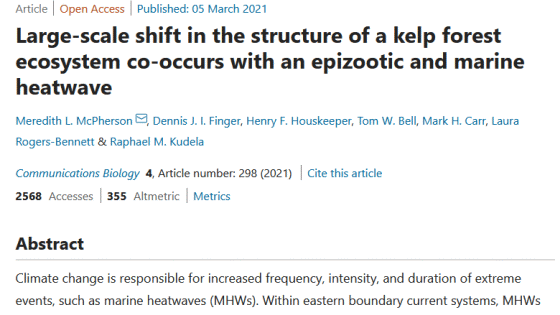'Kelp Forest' has been lost due to the mass breeding of sea urchins

Ecosystems are well-balanced, and the extinction of one species affects many . In northern California, the United States, a widespread 'kelp forest' has been lost due to the reduction in starfish numbers.
Large-scale shift in the structure of a kelp forest ecosystem co-occurs with an epizootic and marine heatwave | Communications Biology
https://www.nature.com/articles/s42003-021-01827-6

The collapse of Northern California kelp forests will be hard to reverse
A research team at the University of California, Santa Cruz , used satellite images from 1985 to 2019 to clarify the relationship between the 'El Nino phenomenon ' in which the temperature of seawater rises and the increase or decrease in the habitat of the kelp family. , We investigated the transition of the habitat of the order Kelp in the northern coast of California.
The survey results look like this. The vertical axis represents latitude, the horizontal axis represents year, and the shades of green indicate the habitat area of Kelp. Until around 2010, many kelp inhabited a wide area, but it can be confirmed that the habitat area has decreased sharply from around 2015.

Below is a diagram comparing the transition of the habitat area of the order Kelp obtained from satellite images with the year of occurrence of the large-scale El Nino phenomenon that occurred in the past. The period during which the El Nino phenomenon occurred is filled with orange or red. If you check the figure, the habitat area of the order Kelp decreased during the period from 1997 to 1998 when the Ernino phenomenon occurred, but the habitat area recovered in 1999. Similarly, when the El Nino phenomenon occurred from 2014 to 2016, the habitat area decreased, but this time the habitat density has not recovered.

Next, the research team, prey on kelp eyes
In the figure below, the green line shows the habitat of Kelp, the orange line shows the seawater temperature, the purple bar shows the population density of purple sea urchin, and the pink bar shows the population density of sunflower sea star. From around 2015, the population density of purple sea urchins has increased as the population density of sunflower starfish has decreased. It can be confirmed that the habitat of the order Kelp has not recovered after the increase of purple sea urchin.

'The kelp can recover its habitat even if it is reduced by the El Nino phenomenon,' said Meredith McPherson, a member of the research team. The increased population of kelp has made it unbearable for the effects of the El Nino phenomenon, 'he said, claiming that the ecosystem surrounding the kelp is out of balance.
According to another study , the purple sea urchin that lives in the area where the habitat of the order Kelp has decreased is undernourished and has no value as food. Therefore, sea otters, which are predators of purple sea urchins, do not prey on purple sea urchins in areas where the habitat area of the order Kelp has decreased, so it is a difficult task to reduce the population density of purple sea urchins.

Related Posts:







